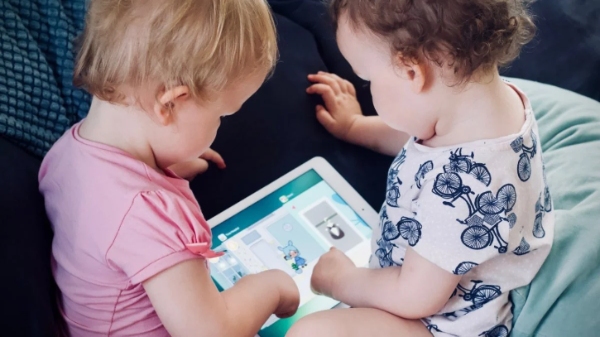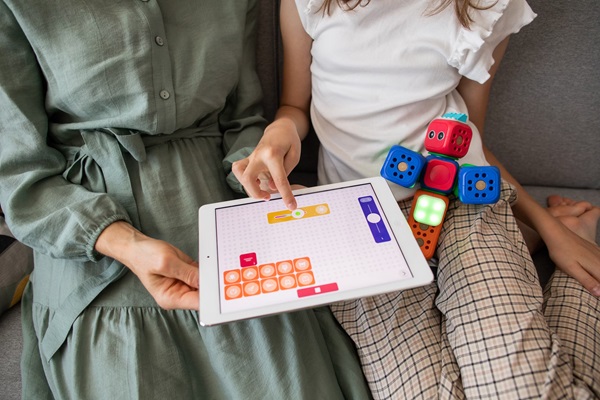Buying a tablet for kids is common in most families nowadays, as they are important tools for enhancing learning and providing entertainment.
However, exposing a child to this digital world at an early age or even without supervision can have some negative impacts.
In this article, we seek to provide guidelines to parents to assist them in deciding when to introduce the tablet to their child and how to do so.
Why do parents give their kids tablets?
Tablets are an essential device today, and many parents incorporate their use into their children’s lives at a young age.



Basically, there are a number of factors that may be responsible for this trend.
- Educational value: Tablets can be an actionable tool for learning with various online resources. These can assist children in improving their reading skills, problem-solving abilities, and creative thinking.
- Entertainment: Various online games, apps, videos, and other activities are great fun for children when they are not busy with study or homework.
- Technological familiarity: The use of gadgets furthermore exposes children at an early age to a computer, which has its benefits as technology advances.
- Communication: Like mobile phones, tablets also support video calls and online chats with family members or friends.
Though some parents use tablets as a way to calm their noisy or otherwise troublesome children, it is not such a great idea.
It may cause the child to become overly reliant on screens and fail to experience live interactions and valuable learning experiences.
It is important to choose the correct tablet for children and install proper restrictions before children are introduced to these gadgets.
The right tablet should be long-lasting, have suitable content for the age of the child, and have strong controls for parents.
These controls assist parents in the regulation of time spent on screens, filtering of content, and guaranteeing the safety of their children online.
What age should a child get a tablet?
Deciding the right age to introduce a tablet to a child is dependent on family values and circumstances.
According to the American Academy of Pediatrics (AAP) guidelines, no child under the age of 18 months should be exposed to screens. This includes tablets, smartphones, and television.



Age-specific considerations:
- 18 to 24 months: Should you consider using a screen, choose quality and educational programming and sit with your child to explain what is being aired.
- 2 to 5 years: Reduce the usage of screens to a maximum of an hour, and keep watching with the child. Focus on educational content and other desirable programs.
- 6 and older: It is still advised to restrict children for a certain number of hours in front of screens, but children can now start using tablets to interact for educational purposes and age-appropriate games.
Experts argue that all aspects, such as focusing on the quality of the content, parental engagement, and shared screen time, should be adhered to regardless of children’s age.
Dr. Jenny Radesky, a pediatrician who focuses on child development, talks about “no screen time zones and no screen time moments,” particularly during mealtime and before bedtime.
Please note that these are general rules of thumb. Parents should also think about the specific need a child has and his or her ability to handle the use of technology.
How to choose the best tablet for your kids?
Choosing the first tablet for a child is a big step, and therefore, it requires careful consideration. Here are key factors to consider:
Budget
Tablets for kids range from $80 to $1000. Think about how much you can spend and what features are important to your goal. Cheaper tablets may not hold up well under some conditions. If your child is very young or clumsy, you may want to invest in a more robust choice regardless of the added price.
User-friendly interface
Intuitive design: The primary factor in ensuring you select the right tablet for your kids is a simple user interface. Symbols should be big and clear, and simple icons should be preferred.
Appropriate size
- Portability: Young children can use smaller tablets more easily, and they can manage them properly.
- Screen size: When choosing the proper tablet size, consider their age and how they will be using it (watching television, games, educational purposes).
Internet parental filters and security options
- Content filtering: Effective parental controls enable a child to lock out content that is indecent.
- Time limits: It should enable you to set rules concerning screen time with a view to maintaining a balance.
- Location tracking: Some tablets come with an added safety feature in the form of a location tracking system for the gadget.
Additional considerations
- Durability: Tablets designed for kids should be durable enough to withstand falling off or spilling something on them. Choose products with a protective case or where the case is an integrated part of the device.
- Storage: You should think about how much storage space your child will require. If they will be watching videos or playing games, you might need more space.
- Battery life: Long battery life is critical for mobile devices, especially for portable entertainment.
- Eye protection: Radiation emitted from the screens is a potential problem since it causes eye strain. Tablet devices with an added blue light filter decrease eye strain.
This way, you will be more likely to find the right tablet that will not only keep your child amused but also be developmentally and safety-appropriate for your child.
5 Best child-friendly tablets
So, let us look through some of the best choices depending on the age and possible requirements.
1. Amazon Fire 7 Kids Edition
Best for: Ages 3-7
This Amazon tablet is specifically made for young kids. They come with a kid-proof case, offer a 2-year worry-free guarantee and a one-year subscription to Amazon Kids+.
It is one of the cheapest subscriptions with a powerful set of filters for child protection and access to a wide range of safe content.
2. Samsung Galaxy A9+
Best for: Ages 8-12
In terms of costs and performance, the Galaxy A9+ is a good model for children, though it does not have child-specific features.
It has a large, colorful, and bright touch screen, and the Google Play store has numerous educational apps and games. Parental controls will have to be set individually.
3. Apple iPad (9th Gen)
Best for: For children 6 years and above
The Apple iPad is versatile enough for both children and adults. It offers excellent performance and features like Screen Time for parental controls.
It’s a more premium option that can grow with your child and is suitable for both educational and entertainment purposes.
4. LeapFrog LeapPad
Best for: Ages 3-7
The LeapFrog LeapPad iPad is ideal for use by children, with good performance and such features as Screen Time for controlling children’s time on the device.
It is a more expensive one that may last longer till your child outgrows it and can be used for learning purposes as well as just a fun filled toy.
5. Contixo
Best for: 2-10 years
Contixo makes Android tablets, which are affordable and mainly targeted at children. It comes with preloaded apps for education, games as well as robust parental locks.
These are good for younger kids or for the first tablet mainly because of their tough construction and because they are much cheaper.
Tips for parents to make kids’ tablet experience positive
A tablet is beneficial for learning and fun activities; however, it is essential to control what your child is exposed to. Here are some tips to ensure a positive experience.



Set up a positive digital ecosystem
- Shared experiences: Treat using tablets as a family affair. Play simple games together, watch fun and interesting videos, or discover a new application.
- Learning opportunities: Make sure to let your child use the tablet only for learning purposes. There are so many applications and games they could easily use to improve their knowledge while being entertained.
Communication and management
- Talk about online safety: Make a point to have a discussion about the dangers of the internet, such as predators and bullying. They should not disclose their details and should inform you if anything is wrong.
- Age-appropriate apps and content: Select applications and games your child would comprehend or find interesting at his or her age. The world out there has many forms of educational and fun content, so go out and explore.
Set clear boundaries and restrictions
- Physical protection: Accidents happen, and therefore, it is recommended that you get a strong carrying case to shield your child’s tablet from falls.
- Time management: Set down specific times for watching television, video, computer games, etc. This helps to harmonize the use of the gadget with physical activities, play, and interactions with the family.
- Parental controls: Use the parental control functions provided by the operating system to set up filters and block specific applications. Moreover, third-party parental control apps can supplement these functions for better security and monitoring.
One such app worth considering is FlashGet Kids. This app offers a range of parental monitoring features that can help create a safer and more controlled digital environment for your children:
- Content filter and app blocker to eliminate access to undesirable content.
- Screen time management helps kids build healthier device usage and lifestyles.
- Detailed app usage reports will assist parents in keeping track of their children’s online activities and digital habits.
- Screen mirroring also allows parents to remotely monitor their child’s mobile phone in real-time.
FlashGet Kids offers very powerful and effective protection while having clear and easy-to-use interfaces for both parents and children. Besides, it works well both on iOS and Android.
It covers many of the typical issues parents have with tablets, which helps to reduce the risk of them being overused and the children becoming overly reliant on them.
Conclusion
Introducing a tablet for kids is a necessary step in today’s world, but it needs proper evaluation and an active approach.
It is not just about selecting the best device but approaching the use of devices in the right way from the very beginning.
If parents establish proper guidelines on the use of tablets, they will be able to reap the benefits of using tablets while avoiding dangerous consequences.

